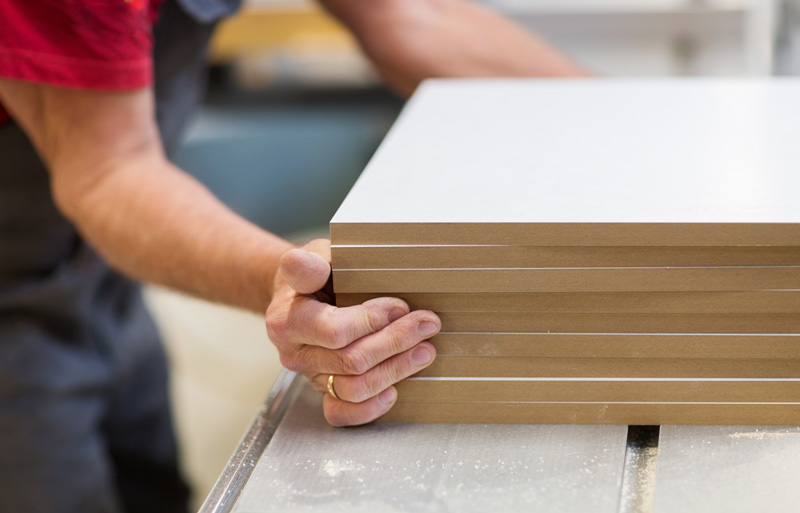Posted: 2nd February 2023 | Author: Adam Brown
Back to news
Close up of a carpenter with a stack of MDF boards in a workshop
If you’re trying to choose the right sheet materials for a project, one option you’re bound to come across is MDF.
But what actually is MDF, how is it made and what benefits does it have to offer? We’ll be answering all of these questions and more here in this handy guide. This should help you work out whether it’s the right choice for your building job.
So, let’s start with the basics.
MDF stands for Medium Density Fibreboard. It’s an engineered wood material, which tends to come in large panels of various thicknesses. Its surface is smooth and free of natural defects.
You can cut and shape MDF boards using standard woodworking tools, which makes it pretty easy to work with. It’s non-structural, but has lots of different uses.
MDF is made by combining wood fibres with synthetic resin adhesive. Firstly, wood residuals are broken down into fine particles. It’s usually softwood, especially in the UK and Ireland. However, some manufacturers of MDF will use a percentage of temperate hardwood if locally available. These wood particles are combined with a wax and resin binder, which is then heated and compressed. This forms highly durable panels.
MDF is a highly versatile material, one that is sanded smooth and easy to work with. This makes it suitable for lots of different applications. Here are just a few examples of the kind of projects it could be a good fit for:
Now, can it be used outside? Most types of MDF aren’t really suitable for outdoor use, as it can swell, warp and eventually decay when exposed to moisture.
However, you can buy water-resistant MDF boards which can be suitable for some outdoor projects. For example, for a shed roof with a waterproof lining over the top.
If sustainability is important to you for your upcoming project, it’s useful to understand a little more about how MDF is made. Plus, how long it lasts, and whether it can be recycled when it comes to the end of its usable life.
Firstly, there’s the manufacturing process to consider. MDF is made from waste or inferior wood materials that aren’t suitable for much else. This otherwise wasted material is effectively repurposed in the making of MDF. It’s also good if the manufacturer has used wood from a sustainable source.
MDF is made by bonding these waste wood particles with synthetic resin adhesive. Depending on the manufacturer, grade and type of board, this adhesive can potentially contain formaldehyde. This is a pollutant which can negatively affect indoor air quality.
Due to the high temperatures and pressures required to bond these materials together, MDF panels can take a lot of energy to manufacture. This energy could come from renewable sources, however.
MDF is generally considered to be a very durable material, if used for the right purposes. For example, if you plan to use it anywhere near moisture, you need to choose a moisture-resistant variety or your MDF won’t last very long. Similarly, if you’re using it to make furniture, it’s a good idea to seal, paint and finish the MDF properly to help it last for longer.
The last thing to consider is whether your used MDF can be recycled at the end of its usable life. It used to be the case that it was considered very difficult to recycle, but the good news is that many local household waste recycling centres now accept MDF.
Back to news
The Author: Adam Brown
With a background as a Mechanical Engineer, I started Nationwide Supplies alongside my brother with a vision to modernise what seemed a stuck-in-its-ways industry in the builders merchant sector. Since 2011 it has been my goal to source quality products at the correct prices to be able to offer a saving to customers along with high quality customer service which offers quick delivery and superior technical knowledge in the industry.